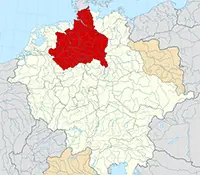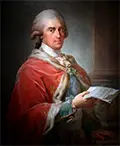Early to Modern Saxony
The land that became Saxony was home to the Saxons, a Germanic tribe, very early on. Before that, it was home to various Celtic tribes. The Saxons expanded across the sea, taking hold in what the Romans called Brittania, in a combination of conquest and settlement. The Saxons were themselves conquered by the Franks, in the 8th Century. And in 843, as a result of the Treaty of Verdun division of land, Saxony became part of East Francia, which became largely Germanic. 
Saxony rose in power and prestige, becoming a hereditary duchy of Liudolfings. The first Saxon King of the Romans was Henry the Fowler, in 919. When Henry died, in 936, his son became King Otto I, whose reign was so influential that he became known as Otto the Great. He later became Holy Roman Emperor. He and his descendants held the German crown for more than a century; some of his successors also were named emperor. 
Also about this time, a noble family, the Billungs, won control of a large amount of land and also won the right to be called Duke of Saxony. They held that title for a few generations and then arrived the influential Guelph dynasty. One of the most powerful of the Saxon dukes was Henry the Lion, who ruled both Saxony and Bavaria in the mid-12th Century. In 1180, the Bishops of Cologne won control of a sizable amount of this land. Eighty years later, what remained of Saxony was split in two. Lower Saxony was more formally known as Saxe-Lauenburg, and Upper Saxony was more formally known as Saxe-Wittenberg. Because Saxony was under the umbrella of the Holy Roman Empire at this time, both states wanted to have the privilege and power of being an elector, someone who had a say in selecting the emperor. Both subdivisions claimed that right, and it was the Holy Roman Emperor Charles IV, in the Golden Bull of 1356, who awarded that right to Saxe-Wittenberg. A century later, the Electorate of Saxony joined with the Margraviate of Meissen, creating a much larger entity that included the large population center of Dresden and the important city of Meissen. Not three generations later came another partition, with a new capital, Wittenberg. For a brief interlude in the late 17th Century and again in the mid-18th Century, the Electors of Saxony also served as King of Poland. That personal union came about as the result of elections by the Polish population. Saxony tested its power in 1756 by joining a coalition consisting of Austria, France, and Russia. The common enemy was Prussia, and that state's king, Frederick the Great, decided to teach his Saxon neighbors a lesson by invading them, sparking the Third Silesian War, which was part of the wider European conflict the Seven Years War. Prussia humbled Saxony on the battlefield and reduced it to second-class status, but a war-ending treaty in 1763 gave Saxony back its independence. 
The next big change for Saxony was the reorganization of it as a kingdom, as established in conjunction with French Emperor Napoleon Bonaparte, who abolished the Holy Roman Empire in 1806 and replaced it with the Confederation of the Rhine. Frederick Augustus III went from being Elector to being King Frederick Augustus I (left), and he remained as such throughout the rest of his life, as his alliance with France resulted in his deposition and then restoration (as a result of the Congress of Vienna). The extreme caveat of that arrangement was that the king lost the northern half of his kingdom to Prussia, which put it together with the Duchy of Magdeburg and the Altmark to make the Province of Saxony, within Prussian borders. What remained of Saxony in 1815 joined the German Confederation. A decade and a half later, then-King Anthony had to cede power to a constitutional government as the result of an uprising. In the wider outbreaks known as the Revolutions of 1848, a later king, Frederick Augustus II, gave up still more power. Not forgetting the enmity, Prussian troops overran Saxony during the Austro-Prussian War in 1866 and then insisted that it join the Prussia-dominated North German Confederation. The penultimate step in the devolution of Saxony came in the Franco-Prussian War, when Saxon troops fought for Prussia. In 1871, freely or not, Saxony joined the German Empire. Kings continued to reign over Saxony, until Frederick Augustus III gave up his throne after the end of World War I. |
|
Social Studies for Kids
copyright 2002–2024
David White




